Service Industry Marketing
VerifiedAdded on 2023/03/17
|16
|3829
|82
AI Summary
This article discusses the factors affecting marketing in the service industry, specifically in education and learning institutions. It explores the student-tutor ratio, class contact hours, teaching qualifications, physical and political learning environment, library facilities, laboratories, marketing communication objectives, competition, convincing strategies, promotional mix, and criteria to measure objectives. The article emphasizes the importance of these factors in delivering quality education and the impact they have on the future of the country.
Contribute Materials
Your contribution can guide someone’s learning journey. Share your
documents today.
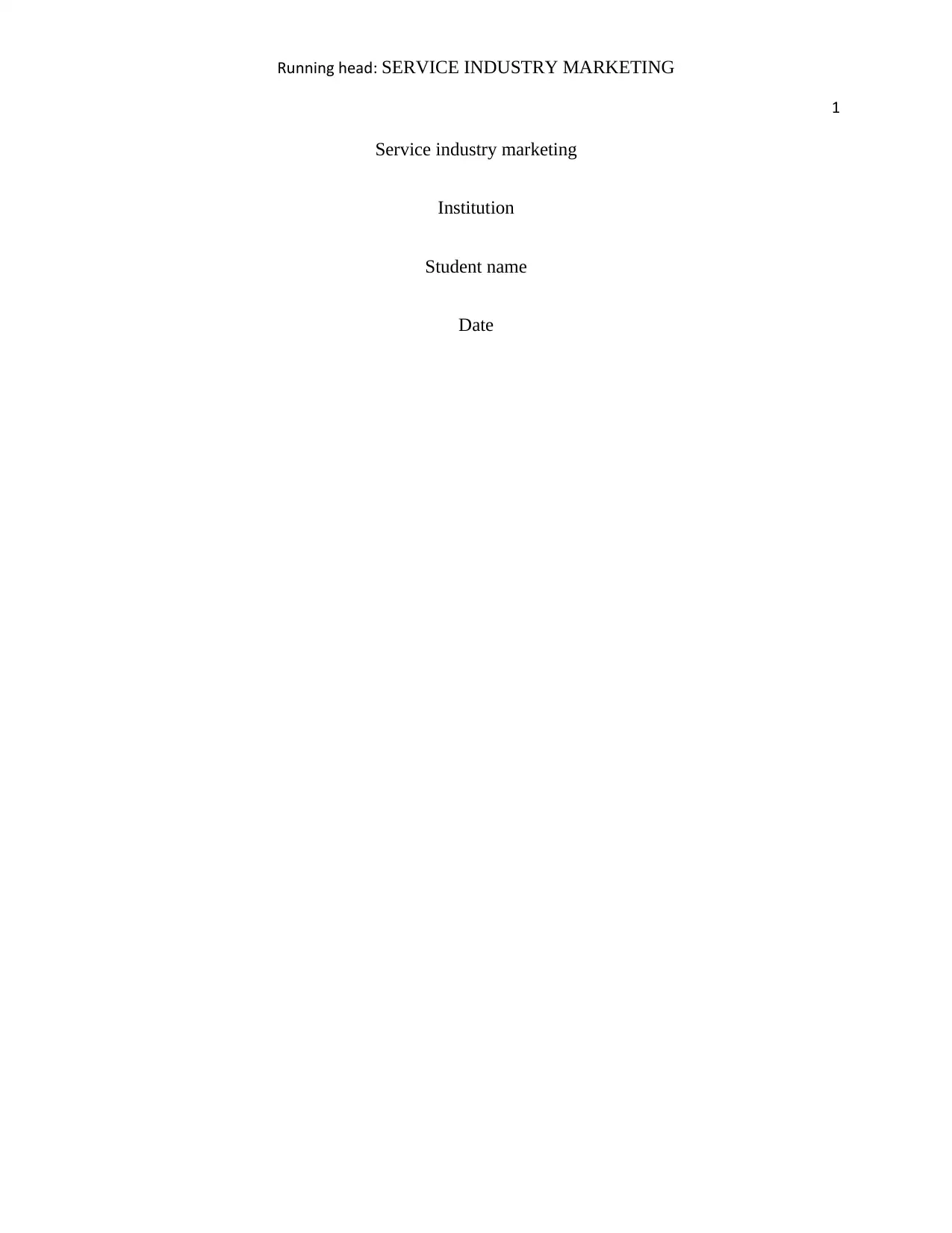
Running head: SERVICE INDUSTRY MARKETING
1
Service industry marketing
Institution
Student name
Date
1
Service industry marketing
Institution
Student name
Date
Secure Best Marks with AI Grader
Need help grading? Try our AI Grader for instant feedback on your assignments.
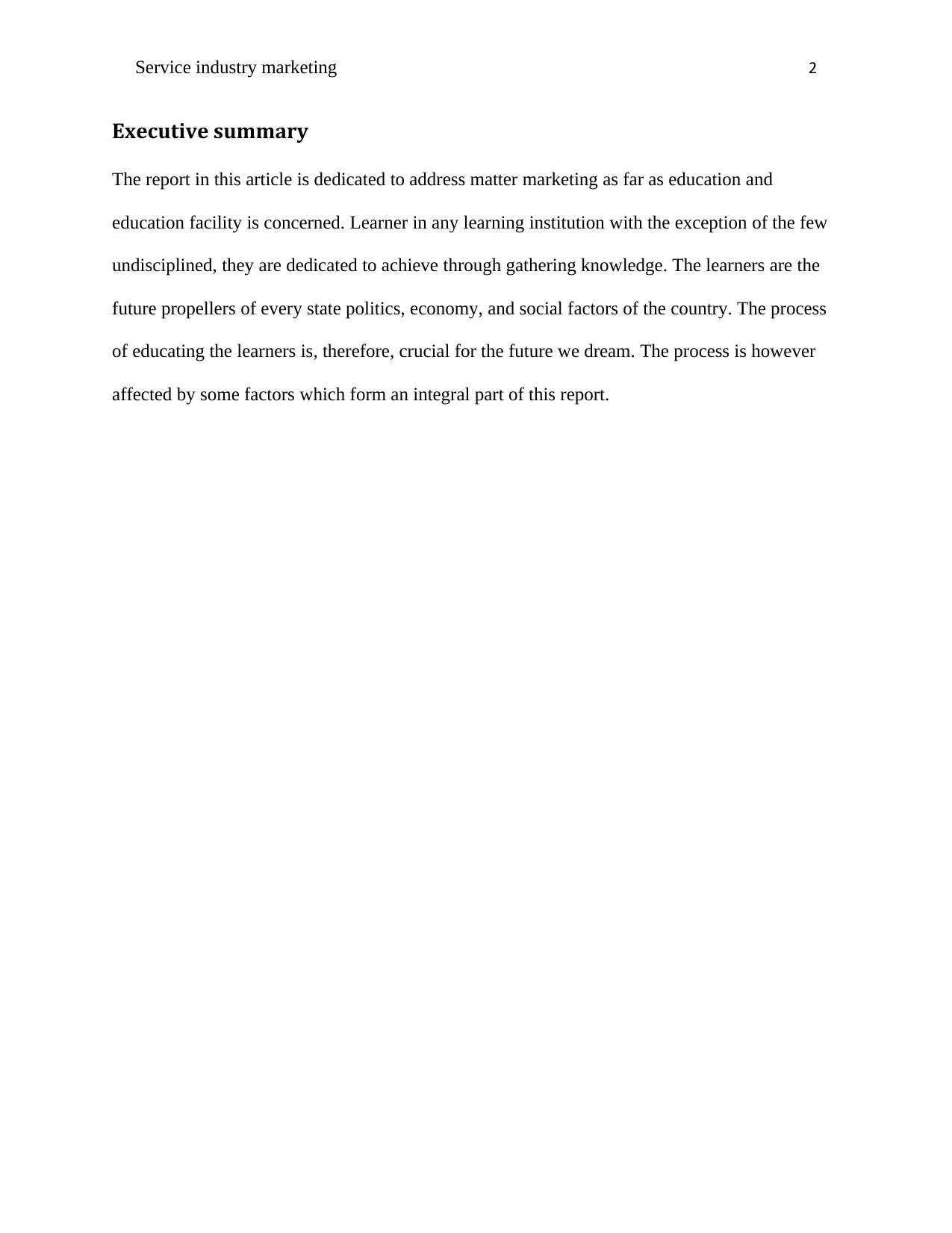
Service industry marketing 2
Executive summary
The report in this article is dedicated to address matter marketing as far as education and
education facility is concerned. Learner in any learning institution with the exception of the few
undisciplined, they are dedicated to achieve through gathering knowledge. The learners are the
future propellers of every state politics, economy, and social factors of the country. The process
of educating the learners is, therefore, crucial for the future we dream. The process is however
affected by some factors which form an integral part of this report.
Executive summary
The report in this article is dedicated to address matter marketing as far as education and
education facility is concerned. Learner in any learning institution with the exception of the few
undisciplined, they are dedicated to achieve through gathering knowledge. The learners are the
future propellers of every state politics, economy, and social factors of the country. The process
of educating the learners is, therefore, crucial for the future we dream. The process is however
affected by some factors which form an integral part of this report.
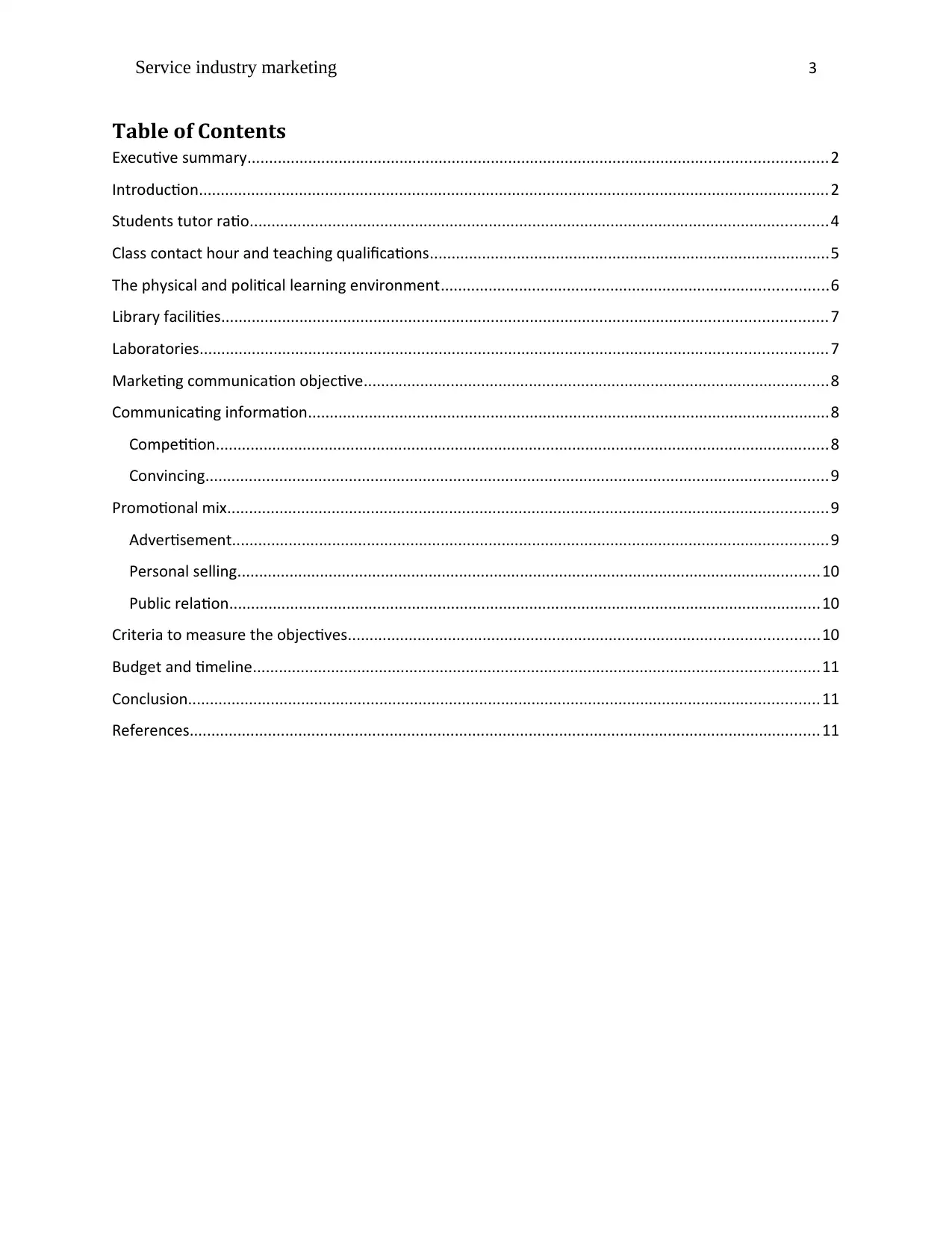
Service industry marketing 3
Table of Contents
Executive summary.....................................................................................................................................2
Introduction.................................................................................................................................................2
Students tutor ratio.....................................................................................................................................4
Class contact hour and teaching qualifications............................................................................................5
The physical and political learning environment.........................................................................................6
Library facilities...........................................................................................................................................7
Laboratories................................................................................................................................................7
Marketing communication objective...........................................................................................................8
Communicating information........................................................................................................................8
Competition.............................................................................................................................................8
Convincing...............................................................................................................................................9
Promotional mix..........................................................................................................................................9
Advertisement.........................................................................................................................................9
Personal selling......................................................................................................................................10
Public relation........................................................................................................................................10
Criteria to measure the objectives............................................................................................................10
Budget and timeline..................................................................................................................................11
Conclusion.................................................................................................................................................11
References.................................................................................................................................................11
Table of Contents
Executive summary.....................................................................................................................................2
Introduction.................................................................................................................................................2
Students tutor ratio.....................................................................................................................................4
Class contact hour and teaching qualifications............................................................................................5
The physical and political learning environment.........................................................................................6
Library facilities...........................................................................................................................................7
Laboratories................................................................................................................................................7
Marketing communication objective...........................................................................................................8
Communicating information........................................................................................................................8
Competition.............................................................................................................................................8
Convincing...............................................................................................................................................9
Promotional mix..........................................................................................................................................9
Advertisement.........................................................................................................................................9
Personal selling......................................................................................................................................10
Public relation........................................................................................................................................10
Criteria to measure the objectives............................................................................................................10
Budget and timeline..................................................................................................................................11
Conclusion.................................................................................................................................................11
References.................................................................................................................................................11
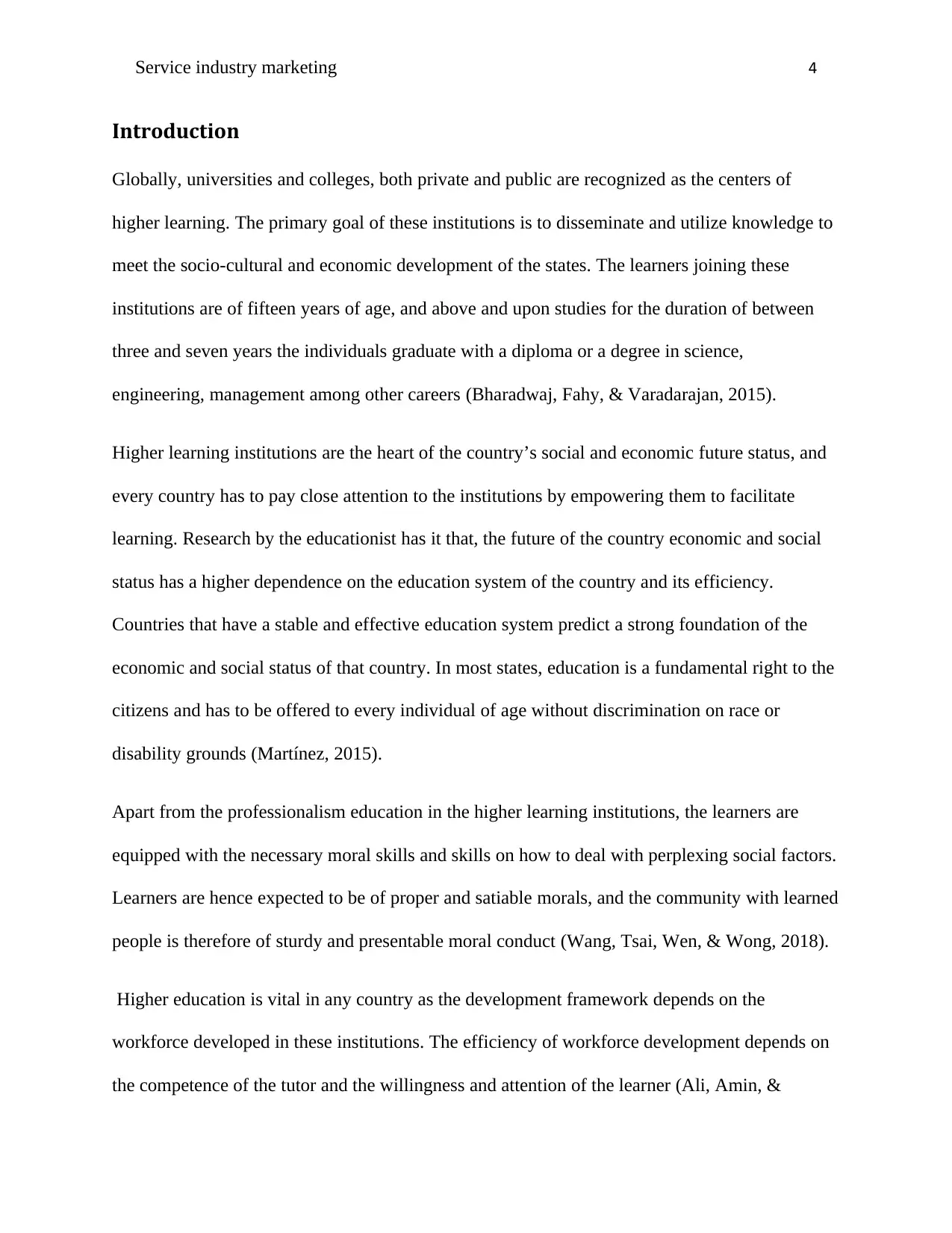
Service industry marketing 4
Introduction
Globally, universities and colleges, both private and public are recognized as the centers of
higher learning. The primary goal of these institutions is to disseminate and utilize knowledge to
meet the socio-cultural and economic development of the states. The learners joining these
institutions are of fifteen years of age, and above and upon studies for the duration of between
three and seven years the individuals graduate with a diploma or a degree in science,
engineering, management among other careers (Bharadwaj, Fahy, & Varadarajan, 2015).
Higher learning institutions are the heart of the country’s social and economic future status, and
every country has to pay close attention to the institutions by empowering them to facilitate
learning. Research by the educationist has it that, the future of the country economic and social
status has a higher dependence on the education system of the country and its efficiency.
Countries that have a stable and effective education system predict a strong foundation of the
economic and social status of that country. In most states, education is a fundamental right to the
citizens and has to be offered to every individual of age without discrimination on race or
disability grounds (Martínez, 2015).
Apart from the professionalism education in the higher learning institutions, the learners are
equipped with the necessary moral skills and skills on how to deal with perplexing social factors.
Learners are hence expected to be of proper and satiable morals, and the community with learned
people is therefore of sturdy and presentable moral conduct (Wang, Tsai, Wen, & Wong, 2018).
Higher education is vital in any country as the development framework depends on the
workforce developed in these institutions. The efficiency of workforce development depends on
the competence of the tutor and the willingness and attention of the learner (Ali, Amin, &
Introduction
Globally, universities and colleges, both private and public are recognized as the centers of
higher learning. The primary goal of these institutions is to disseminate and utilize knowledge to
meet the socio-cultural and economic development of the states. The learners joining these
institutions are of fifteen years of age, and above and upon studies for the duration of between
three and seven years the individuals graduate with a diploma or a degree in science,
engineering, management among other careers (Bharadwaj, Fahy, & Varadarajan, 2015).
Higher learning institutions are the heart of the country’s social and economic future status, and
every country has to pay close attention to the institutions by empowering them to facilitate
learning. Research by the educationist has it that, the future of the country economic and social
status has a higher dependence on the education system of the country and its efficiency.
Countries that have a stable and effective education system predict a strong foundation of the
economic and social status of that country. In most states, education is a fundamental right to the
citizens and has to be offered to every individual of age without discrimination on race or
disability grounds (Martínez, 2015).
Apart from the professionalism education in the higher learning institutions, the learners are
equipped with the necessary moral skills and skills on how to deal with perplexing social factors.
Learners are hence expected to be of proper and satiable morals, and the community with learned
people is therefore of sturdy and presentable moral conduct (Wang, Tsai, Wen, & Wong, 2018).
Higher education is vital in any country as the development framework depends on the
workforce developed in these institutions. The efficiency of workforce development depends on
the competence of the tutor and the willingness and attention of the learner (Ali, Amin, &
Secure Best Marks with AI Grader
Need help grading? Try our AI Grader for instant feedback on your assignments.
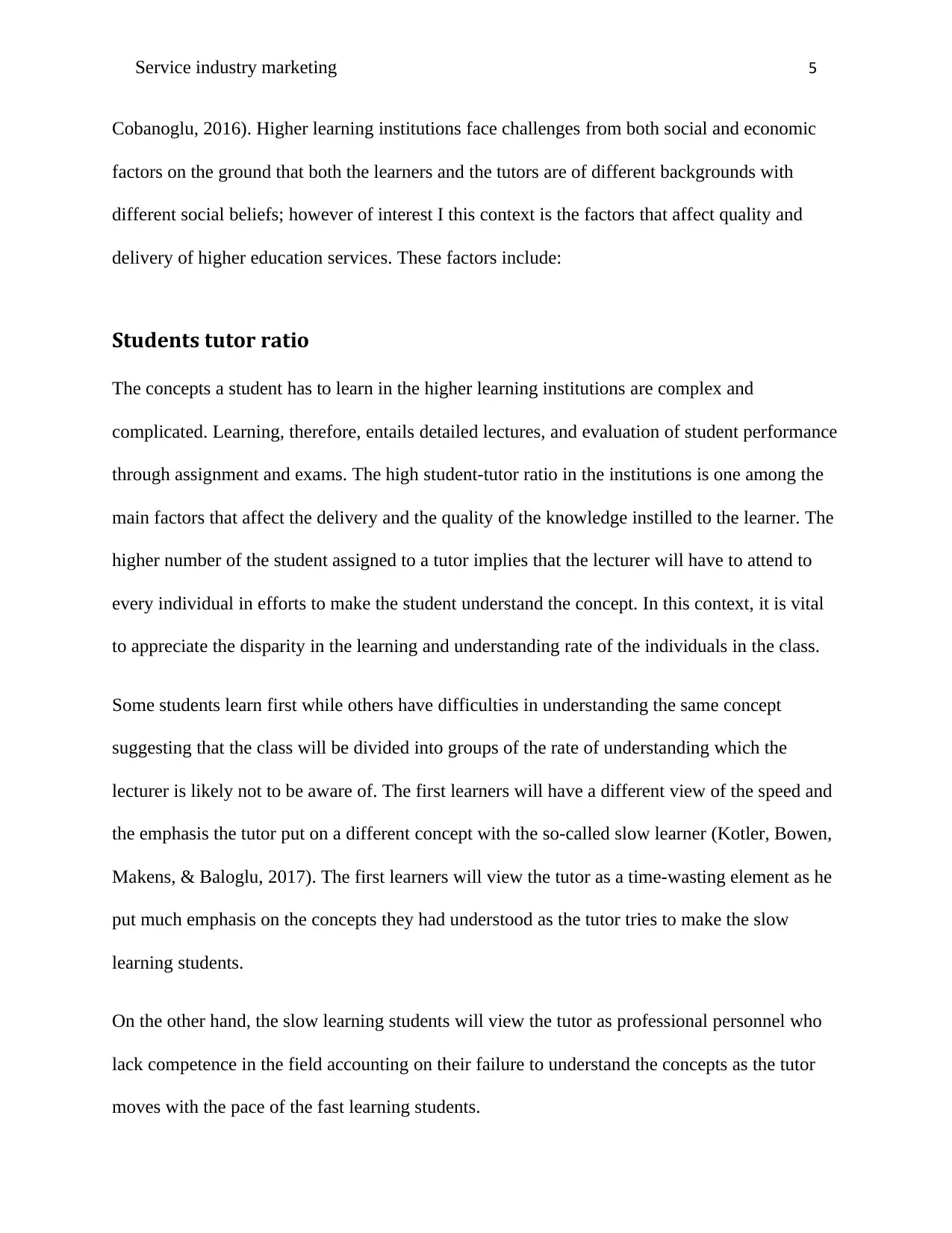
Service industry marketing 5
Cobanoglu, 2016). Higher learning institutions face challenges from both social and economic
factors on the ground that both the learners and the tutors are of different backgrounds with
different social beliefs; however of interest I this context is the factors that affect quality and
delivery of higher education services. These factors include:
Students tutor ratio
The concepts a student has to learn in the higher learning institutions are complex and
complicated. Learning, therefore, entails detailed lectures, and evaluation of student performance
through assignment and exams. The high student-tutor ratio in the institutions is one among the
main factors that affect the delivery and the quality of the knowledge instilled to the learner. The
higher number of the student assigned to a tutor implies that the lecturer will have to attend to
every individual in efforts to make the student understand the concept. In this context, it is vital
to appreciate the disparity in the learning and understanding rate of the individuals in the class.
Some students learn first while others have difficulties in understanding the same concept
suggesting that the class will be divided into groups of the rate of understanding which the
lecturer is likely not to be aware of. The first learners will have a different view of the speed and
the emphasis the tutor put on a different concept with the so-called slow learner (Kotler, Bowen,
Makens, & Baloglu, 2017). The first learners will view the tutor as a time-wasting element as he
put much emphasis on the concepts they had understood as the tutor tries to make the slow
learning students.
On the other hand, the slow learning students will view the tutor as professional personnel who
lack competence in the field accounting on their failure to understand the concepts as the tutor
moves with the pace of the fast learning students.
Cobanoglu, 2016). Higher learning institutions face challenges from both social and economic
factors on the ground that both the learners and the tutors are of different backgrounds with
different social beliefs; however of interest I this context is the factors that affect quality and
delivery of higher education services. These factors include:
Students tutor ratio
The concepts a student has to learn in the higher learning institutions are complex and
complicated. Learning, therefore, entails detailed lectures, and evaluation of student performance
through assignment and exams. The high student-tutor ratio in the institutions is one among the
main factors that affect the delivery and the quality of the knowledge instilled to the learner. The
higher number of the student assigned to a tutor implies that the lecturer will have to attend to
every individual in efforts to make the student understand the concept. In this context, it is vital
to appreciate the disparity in the learning and understanding rate of the individuals in the class.
Some students learn first while others have difficulties in understanding the same concept
suggesting that the class will be divided into groups of the rate of understanding which the
lecturer is likely not to be aware of. The first learners will have a different view of the speed and
the emphasis the tutor put on a different concept with the so-called slow learner (Kotler, Bowen,
Makens, & Baloglu, 2017). The first learners will view the tutor as a time-wasting element as he
put much emphasis on the concepts they had understood as the tutor tries to make the slow
learning students.
On the other hand, the slow learning students will view the tutor as professional personnel who
lack competence in the field accounting on their failure to understand the concepts as the tutor
moves with the pace of the fast learning students.
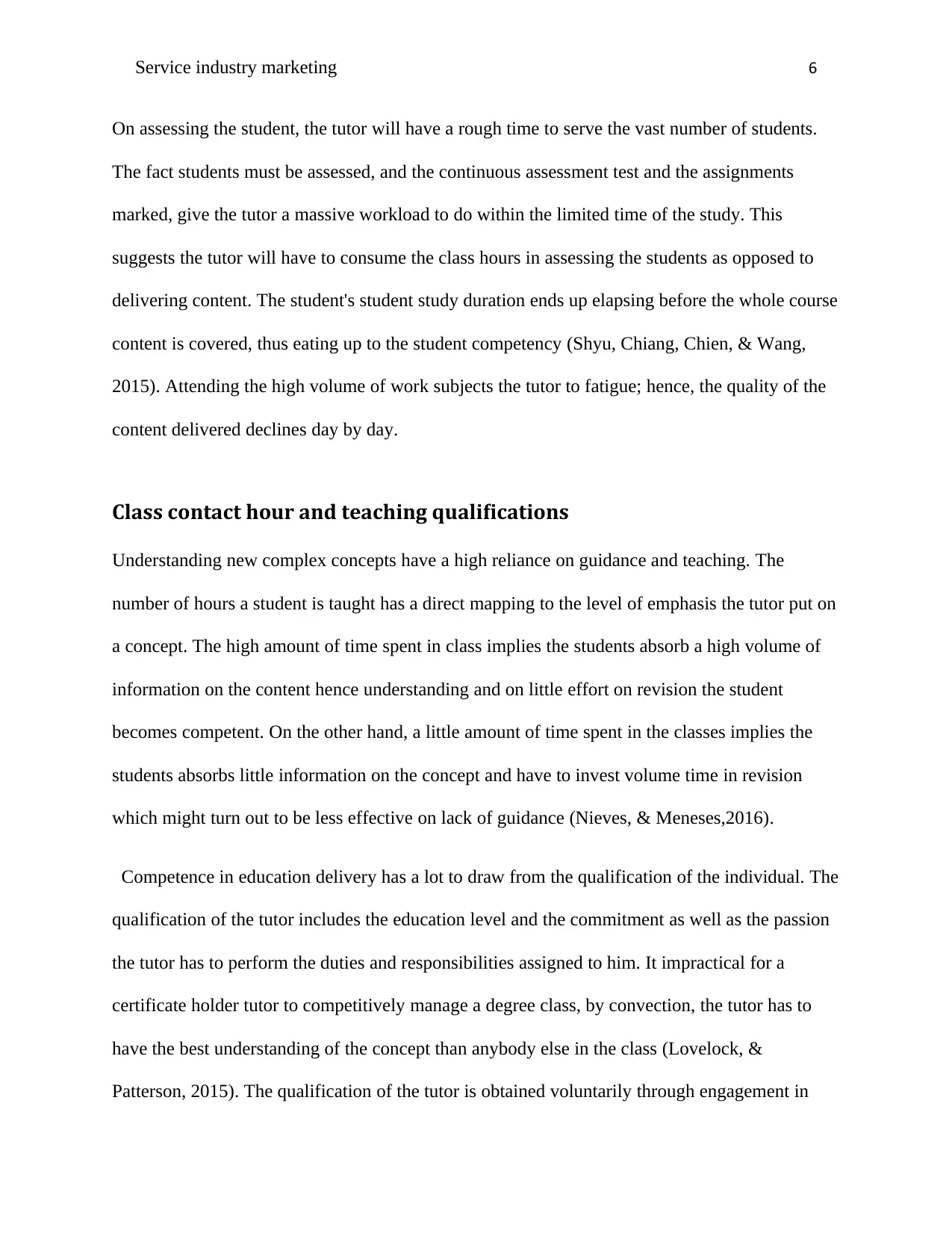
Service industry marketing 6
On assessing the student, the tutor will have a rough time to serve the vast number of students.
The fact students must be assessed, and the continuous assessment test and the assignments
marked, give the tutor a massive workload to do within the limited time of the study. This
suggests the tutor will have to consume the class hours in assessing the students as opposed to
delivering content. The student's student study duration ends up elapsing before the whole course
content is covered, thus eating up to the student competency (Shyu, Chiang, Chien, & Wang,
2015). Attending the high volume of work subjects the tutor to fatigue; hence, the quality of the
content delivered declines day by day.
Class contact hour and teaching qualifications
Understanding new complex concepts have a high reliance on guidance and teaching. The
number of hours a student is taught has a direct mapping to the level of emphasis the tutor put on
a concept. The high amount of time spent in class implies the students absorb a high volume of
information on the content hence understanding and on little effort on revision the student
becomes competent. On the other hand, a little amount of time spent in the classes implies the
students absorbs little information on the concept and have to invest volume time in revision
which might turn out to be less effective on lack of guidance (Nieves, & Meneses,2016).
Competence in education delivery has a lot to draw from the qualification of the individual. The
qualification of the tutor includes the education level and the commitment as well as the passion
the tutor has to perform the duties and responsibilities assigned to him. It impractical for a
certificate holder tutor to competitively manage a degree class, by convection, the tutor has to
have the best understanding of the concept than anybody else in the class (Lovelock, &
Patterson, 2015). The qualification of the tutor is obtained voluntarily through engagement in
On assessing the student, the tutor will have a rough time to serve the vast number of students.
The fact students must be assessed, and the continuous assessment test and the assignments
marked, give the tutor a massive workload to do within the limited time of the study. This
suggests the tutor will have to consume the class hours in assessing the students as opposed to
delivering content. The student's student study duration ends up elapsing before the whole course
content is covered, thus eating up to the student competency (Shyu, Chiang, Chien, & Wang,
2015). Attending the high volume of work subjects the tutor to fatigue; hence, the quality of the
content delivered declines day by day.
Class contact hour and teaching qualifications
Understanding new complex concepts have a high reliance on guidance and teaching. The
number of hours a student is taught has a direct mapping to the level of emphasis the tutor put on
a concept. The high amount of time spent in class implies the students absorb a high volume of
information on the content hence understanding and on little effort on revision the student
becomes competent. On the other hand, a little amount of time spent in the classes implies the
students absorbs little information on the concept and have to invest volume time in revision
which might turn out to be less effective on lack of guidance (Nieves, & Meneses,2016).
Competence in education delivery has a lot to draw from the qualification of the individual. The
qualification of the tutor includes the education level and the commitment as well as the passion
the tutor has to perform the duties and responsibilities assigned to him. It impractical for a
certificate holder tutor to competitively manage a degree class, by convection, the tutor has to
have the best understanding of the concept than anybody else in the class (Lovelock, &
Patterson, 2015). The qualification of the tutor is obtained voluntarily through engagement in
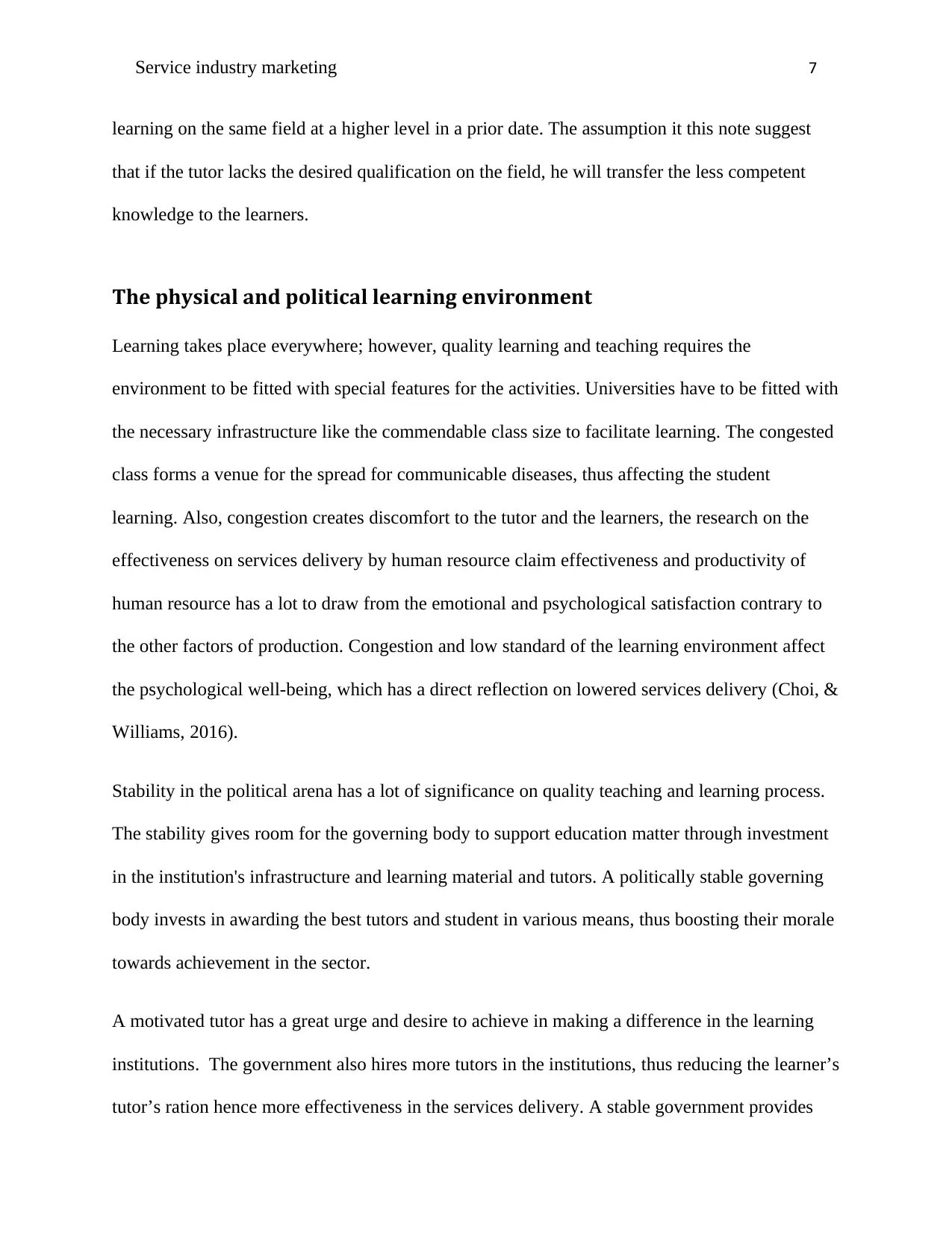
Service industry marketing 7
learning on the same field at a higher level in a prior date. The assumption it this note suggest
that if the tutor lacks the desired qualification on the field, he will transfer the less competent
knowledge to the learners.
The physical and political learning environment
Learning takes place everywhere; however, quality learning and teaching requires the
environment to be fitted with special features for the activities. Universities have to be fitted with
the necessary infrastructure like the commendable class size to facilitate learning. The congested
class forms a venue for the spread for communicable diseases, thus affecting the student
learning. Also, congestion creates discomfort to the tutor and the learners, the research on the
effectiveness on services delivery by human resource claim effectiveness and productivity of
human resource has a lot to draw from the emotional and psychological satisfaction contrary to
the other factors of production. Congestion and low standard of the learning environment affect
the psychological well-being, which has a direct reflection on lowered services delivery (Choi, &
Williams, 2016).
Stability in the political arena has a lot of significance on quality teaching and learning process.
The stability gives room for the governing body to support education matter through investment
in the institution's infrastructure and learning material and tutors. A politically stable governing
body invests in awarding the best tutors and student in various means, thus boosting their morale
towards achievement in the sector.
A motivated tutor has a great urge and desire to achieve in making a difference in the learning
institutions. The government also hires more tutors in the institutions, thus reducing the learner’s
tutor’s ration hence more effectiveness in the services delivery. A stable government provides
learning on the same field at a higher level in a prior date. The assumption it this note suggest
that if the tutor lacks the desired qualification on the field, he will transfer the less competent
knowledge to the learners.
The physical and political learning environment
Learning takes place everywhere; however, quality learning and teaching requires the
environment to be fitted with special features for the activities. Universities have to be fitted with
the necessary infrastructure like the commendable class size to facilitate learning. The congested
class forms a venue for the spread for communicable diseases, thus affecting the student
learning. Also, congestion creates discomfort to the tutor and the learners, the research on the
effectiveness on services delivery by human resource claim effectiveness and productivity of
human resource has a lot to draw from the emotional and psychological satisfaction contrary to
the other factors of production. Congestion and low standard of the learning environment affect
the psychological well-being, which has a direct reflection on lowered services delivery (Choi, &
Williams, 2016).
Stability in the political arena has a lot of significance on quality teaching and learning process.
The stability gives room for the governing body to support education matter through investment
in the institution's infrastructure and learning material and tutors. A politically stable governing
body invests in awarding the best tutors and student in various means, thus boosting their morale
towards achievement in the sector.
A motivated tutor has a great urge and desire to achieve in making a difference in the learning
institutions. The government also hires more tutors in the institutions, thus reducing the learner’s
tutor’s ration hence more effectiveness in the services delivery. A stable government provides
Paraphrase This Document
Need a fresh take? Get an instant paraphrase of this document with our AI Paraphraser
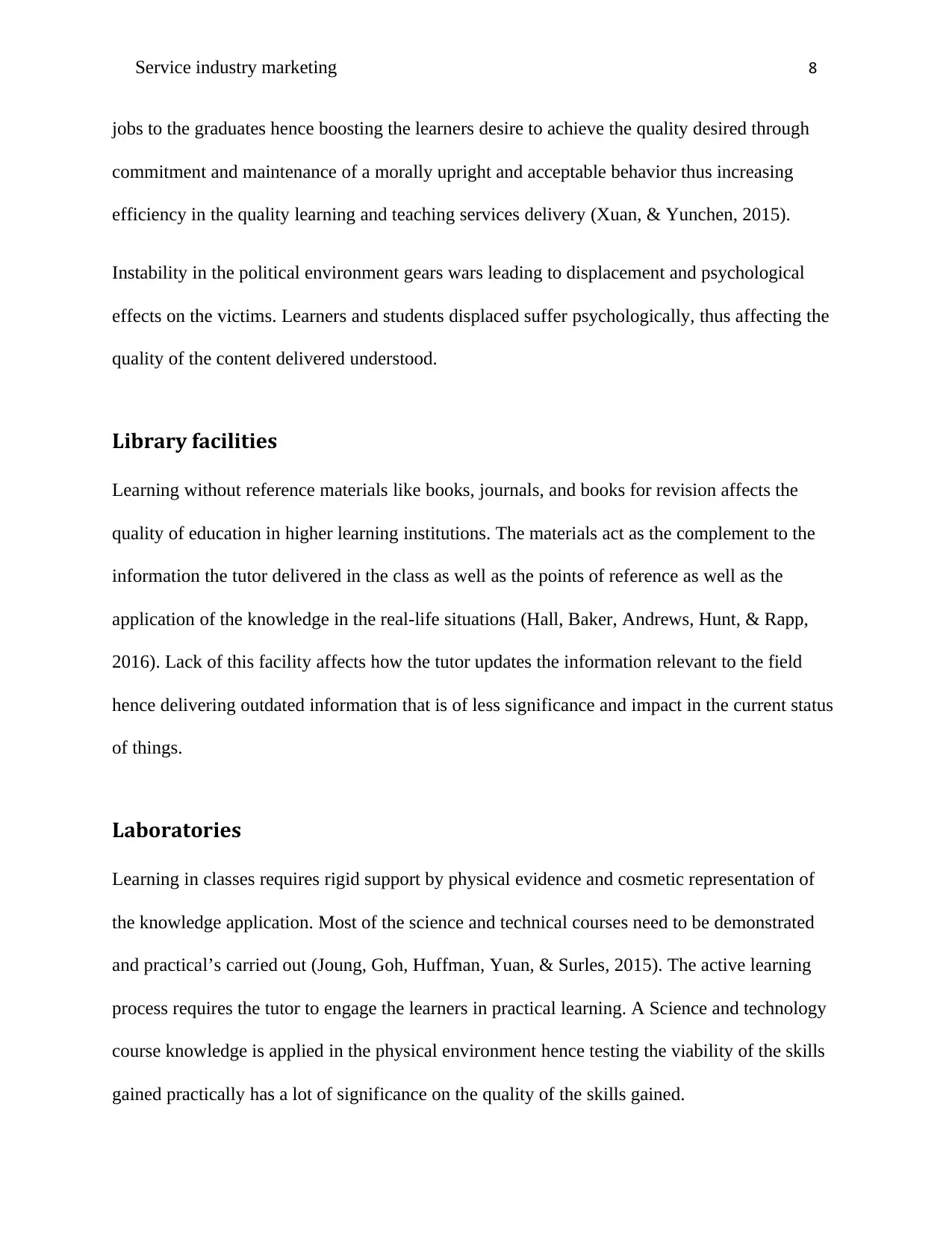
Service industry marketing 8
jobs to the graduates hence boosting the learners desire to achieve the quality desired through
commitment and maintenance of a morally upright and acceptable behavior thus increasing
efficiency in the quality learning and teaching services delivery (Xuan, & Yunchen, 2015).
Instability in the political environment gears wars leading to displacement and psychological
effects on the victims. Learners and students displaced suffer psychologically, thus affecting the
quality of the content delivered understood.
Library facilities
Learning without reference materials like books, journals, and books for revision affects the
quality of education in higher learning institutions. The materials act as the complement to the
information the tutor delivered in the class as well as the points of reference as well as the
application of the knowledge in the real-life situations (Hall, Baker, Andrews, Hunt, & Rapp,
2016). Lack of this facility affects how the tutor updates the information relevant to the field
hence delivering outdated information that is of less significance and impact in the current status
of things.
Laboratories
Learning in classes requires rigid support by physical evidence and cosmetic representation of
the knowledge application. Most of the science and technical courses need to be demonstrated
and practical’s carried out (Joung, Goh, Huffman, Yuan, & Surles, 2015). The active learning
process requires the tutor to engage the learners in practical learning. A Science and technology
course knowledge is applied in the physical environment hence testing the viability of the skills
gained practically has a lot of significance on the quality of the skills gained.
jobs to the graduates hence boosting the learners desire to achieve the quality desired through
commitment and maintenance of a morally upright and acceptable behavior thus increasing
efficiency in the quality learning and teaching services delivery (Xuan, & Yunchen, 2015).
Instability in the political environment gears wars leading to displacement and psychological
effects on the victims. Learners and students displaced suffer psychologically, thus affecting the
quality of the content delivered understood.
Library facilities
Learning without reference materials like books, journals, and books for revision affects the
quality of education in higher learning institutions. The materials act as the complement to the
information the tutor delivered in the class as well as the points of reference as well as the
application of the knowledge in the real-life situations (Hall, Baker, Andrews, Hunt, & Rapp,
2016). Lack of this facility affects how the tutor updates the information relevant to the field
hence delivering outdated information that is of less significance and impact in the current status
of things.
Laboratories
Learning in classes requires rigid support by physical evidence and cosmetic representation of
the knowledge application. Most of the science and technical courses need to be demonstrated
and practical’s carried out (Joung, Goh, Huffman, Yuan, & Surles, 2015). The active learning
process requires the tutor to engage the learners in practical learning. A Science and technology
course knowledge is applied in the physical environment hence testing the viability of the skills
gained practically has a lot of significance on the quality of the skills gained.
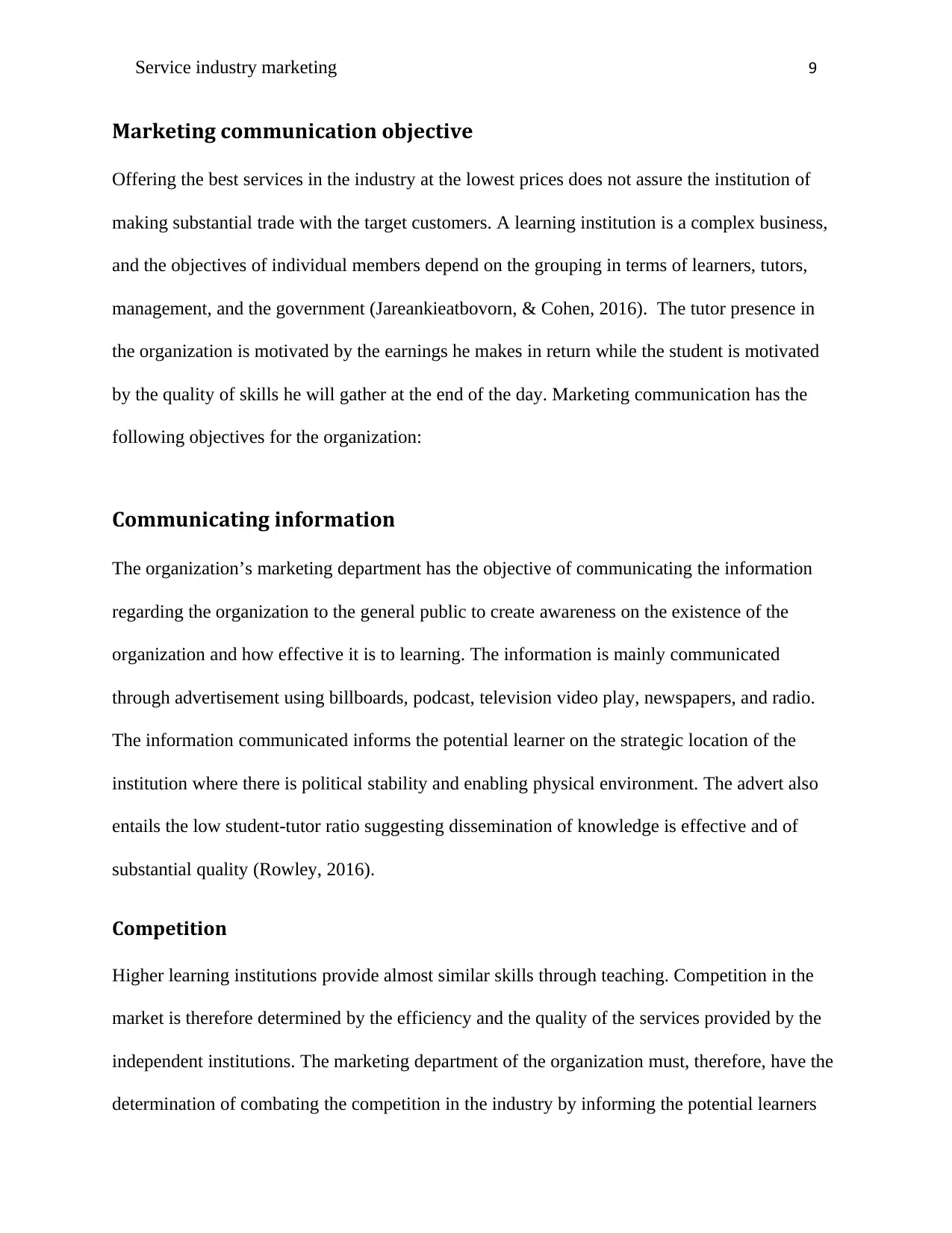
Service industry marketing 9
Marketing communication objective
Offering the best services in the industry at the lowest prices does not assure the institution of
making substantial trade with the target customers. A learning institution is a complex business,
and the objectives of individual members depend on the grouping in terms of learners, tutors,
management, and the government (Jareankieatbovorn, & Cohen, 2016). The tutor presence in
the organization is motivated by the earnings he makes in return while the student is motivated
by the quality of skills he will gather at the end of the day. Marketing communication has the
following objectives for the organization:
Communicating information
The organization’s marketing department has the objective of communicating the information
regarding the organization to the general public to create awareness on the existence of the
organization and how effective it is to learning. The information is mainly communicated
through advertisement using billboards, podcast, television video play, newspapers, and radio.
The information communicated informs the potential learner on the strategic location of the
institution where there is political stability and enabling physical environment. The advert also
entails the low student-tutor ratio suggesting dissemination of knowledge is effective and of
substantial quality (Rowley, 2016).
Competition
Higher learning institutions provide almost similar skills through teaching. Competition in the
market is therefore determined by the efficiency and the quality of the services provided by the
independent institutions. The marketing department of the organization must, therefore, have the
determination of combating the competition in the industry by informing the potential learners
Marketing communication objective
Offering the best services in the industry at the lowest prices does not assure the institution of
making substantial trade with the target customers. A learning institution is a complex business,
and the objectives of individual members depend on the grouping in terms of learners, tutors,
management, and the government (Jareankieatbovorn, & Cohen, 2016). The tutor presence in
the organization is motivated by the earnings he makes in return while the student is motivated
by the quality of skills he will gather at the end of the day. Marketing communication has the
following objectives for the organization:
Communicating information
The organization’s marketing department has the objective of communicating the information
regarding the organization to the general public to create awareness on the existence of the
organization and how effective it is to learning. The information is mainly communicated
through advertisement using billboards, podcast, television video play, newspapers, and radio.
The information communicated informs the potential learner on the strategic location of the
institution where there is political stability and enabling physical environment. The advert also
entails the low student-tutor ratio suggesting dissemination of knowledge is effective and of
substantial quality (Rowley, 2016).
Competition
Higher learning institutions provide almost similar skills through teaching. Competition in the
market is therefore determined by the efficiency and the quality of the services provided by the
independent institutions. The marketing department of the organization must, therefore, have the
determination of combating the competition in the industry by informing the potential learners
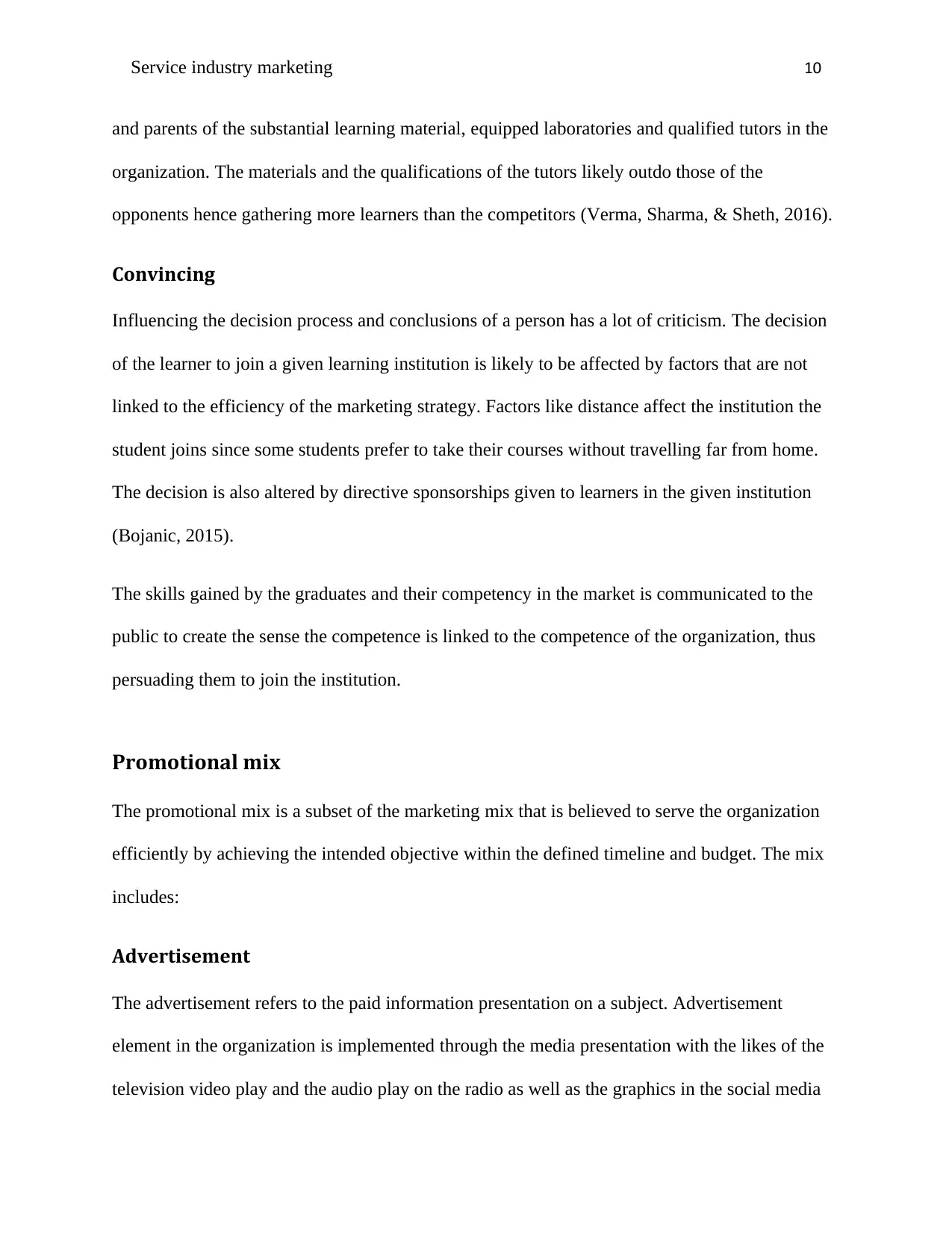
Service industry marketing 10
and parents of the substantial learning material, equipped laboratories and qualified tutors in the
organization. The materials and the qualifications of the tutors likely outdo those of the
opponents hence gathering more learners than the competitors (Verma, Sharma, & Sheth, 2016).
Convincing
Influencing the decision process and conclusions of a person has a lot of criticism. The decision
of the learner to join a given learning institution is likely to be affected by factors that are not
linked to the efficiency of the marketing strategy. Factors like distance affect the institution the
student joins since some students prefer to take their courses without travelling far from home.
The decision is also altered by directive sponsorships given to learners in the given institution
(Bojanic, 2015).
The skills gained by the graduates and their competency in the market is communicated to the
public to create the sense the competence is linked to the competence of the organization, thus
persuading them to join the institution.
Promotional mix
The promotional mix is a subset of the marketing mix that is believed to serve the organization
efficiently by achieving the intended objective within the defined timeline and budget. The mix
includes:
Advertisement
The advertisement refers to the paid information presentation on a subject. Advertisement
element in the organization is implemented through the media presentation with the likes of the
television video play and the audio play on the radio as well as the graphics in the social media
and parents of the substantial learning material, equipped laboratories and qualified tutors in the
organization. The materials and the qualifications of the tutors likely outdo those of the
opponents hence gathering more learners than the competitors (Verma, Sharma, & Sheth, 2016).
Convincing
Influencing the decision process and conclusions of a person has a lot of criticism. The decision
of the learner to join a given learning institution is likely to be affected by factors that are not
linked to the efficiency of the marketing strategy. Factors like distance affect the institution the
student joins since some students prefer to take their courses without travelling far from home.
The decision is also altered by directive sponsorships given to learners in the given institution
(Bojanic, 2015).
The skills gained by the graduates and their competency in the market is communicated to the
public to create the sense the competence is linked to the competence of the organization, thus
persuading them to join the institution.
Promotional mix
The promotional mix is a subset of the marketing mix that is believed to serve the organization
efficiently by achieving the intended objective within the defined timeline and budget. The mix
includes:
Advertisement
The advertisement refers to the paid information presentation on a subject. Advertisement
element in the organization is implemented through the media presentation with the likes of the
television video play and the audio play on the radio as well as the graphics in the social media
Secure Best Marks with AI Grader
Need help grading? Try our AI Grader for instant feedback on your assignments.
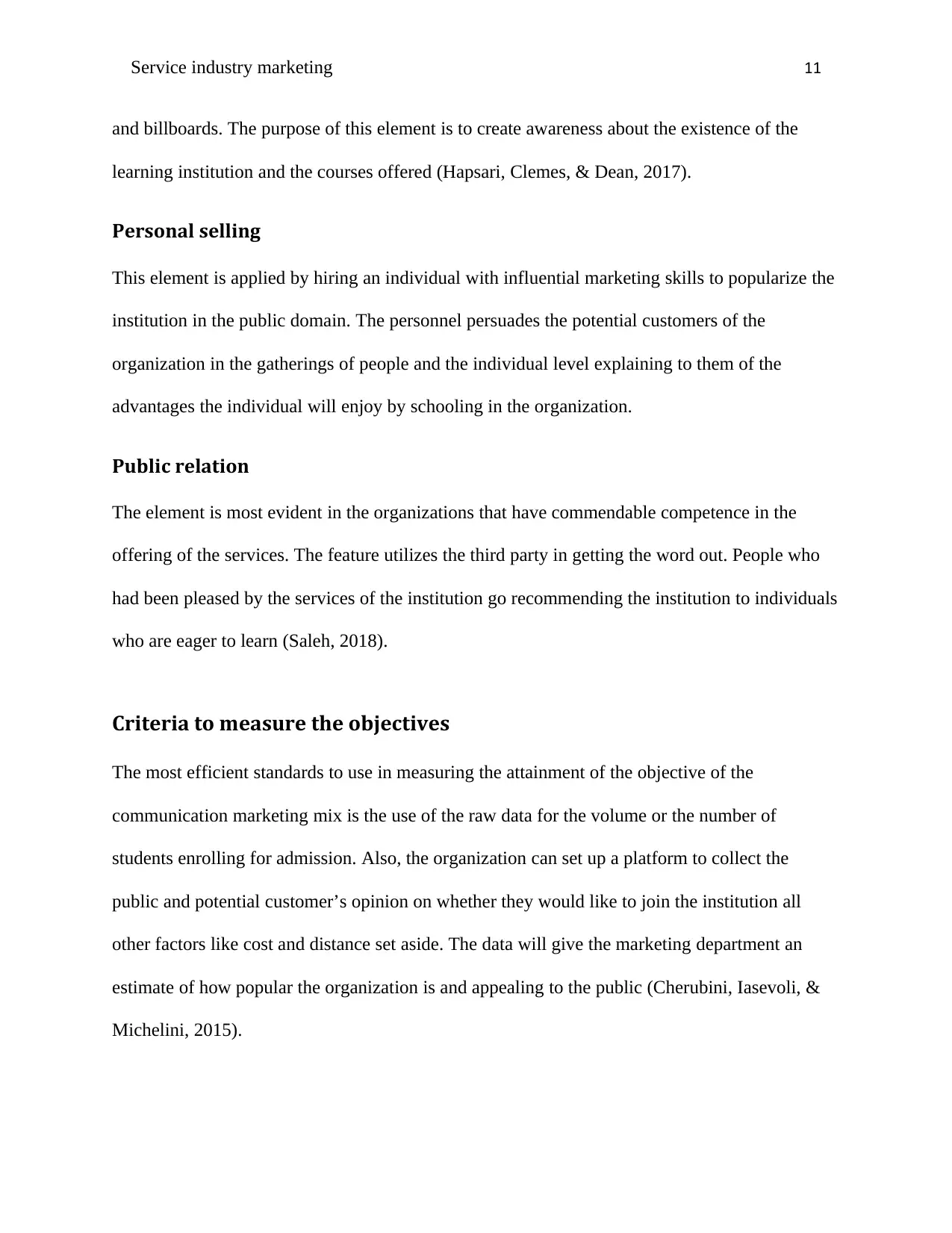
Service industry marketing 11
and billboards. The purpose of this element is to create awareness about the existence of the
learning institution and the courses offered (Hapsari, Clemes, & Dean, 2017).
Personal selling
This element is applied by hiring an individual with influential marketing skills to popularize the
institution in the public domain. The personnel persuades the potential customers of the
organization in the gatherings of people and the individual level explaining to them of the
advantages the individual will enjoy by schooling in the organization.
Public relation
The element is most evident in the organizations that have commendable competence in the
offering of the services. The feature utilizes the third party in getting the word out. People who
had been pleased by the services of the institution go recommending the institution to individuals
who are eager to learn (Saleh, 2018).
Criteria to measure the objectives
The most efficient standards to use in measuring the attainment of the objective of the
communication marketing mix is the use of the raw data for the volume or the number of
students enrolling for admission. Also, the organization can set up a platform to collect the
public and potential customer’s opinion on whether they would like to join the institution all
other factors like cost and distance set aside. The data will give the marketing department an
estimate of how popular the organization is and appealing to the public (Cherubini, Iasevoli, &
Michelini, 2015).
and billboards. The purpose of this element is to create awareness about the existence of the
learning institution and the courses offered (Hapsari, Clemes, & Dean, 2017).
Personal selling
This element is applied by hiring an individual with influential marketing skills to popularize the
institution in the public domain. The personnel persuades the potential customers of the
organization in the gatherings of people and the individual level explaining to them of the
advantages the individual will enjoy by schooling in the organization.
Public relation
The element is most evident in the organizations that have commendable competence in the
offering of the services. The feature utilizes the third party in getting the word out. People who
had been pleased by the services of the institution go recommending the institution to individuals
who are eager to learn (Saleh, 2018).
Criteria to measure the objectives
The most efficient standards to use in measuring the attainment of the objective of the
communication marketing mix is the use of the raw data for the volume or the number of
students enrolling for admission. Also, the organization can set up a platform to collect the
public and potential customer’s opinion on whether they would like to join the institution all
other factors like cost and distance set aside. The data will give the marketing department an
estimate of how popular the organization is and appealing to the public (Cherubini, Iasevoli, &
Michelini, 2015).
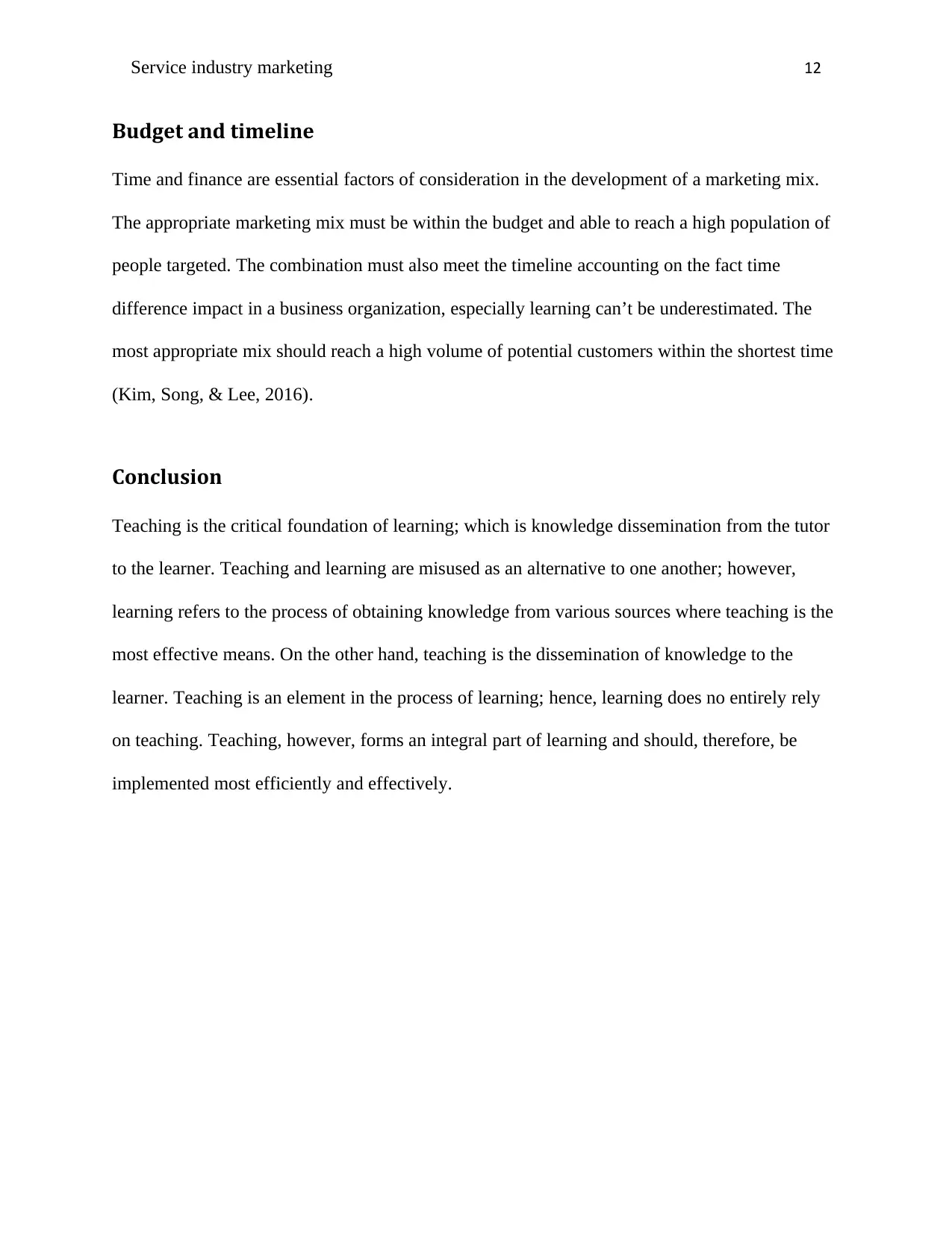
Service industry marketing 12
Budget and timeline
Time and finance are essential factors of consideration in the development of a marketing mix.
The appropriate marketing mix must be within the budget and able to reach a high population of
people targeted. The combination must also meet the timeline accounting on the fact time
difference impact in a business organization, especially learning can’t be underestimated. The
most appropriate mix should reach a high volume of potential customers within the shortest time
(Kim, Song, & Lee, 2016).
Conclusion
Teaching is the critical foundation of learning; which is knowledge dissemination from the tutor
to the learner. Teaching and learning are misused as an alternative to one another; however,
learning refers to the process of obtaining knowledge from various sources where teaching is the
most effective means. On the other hand, teaching is the dissemination of knowledge to the
learner. Teaching is an element in the process of learning; hence, learning does no entirely rely
on teaching. Teaching, however, forms an integral part of learning and should, therefore, be
implemented most efficiently and effectively.
Budget and timeline
Time and finance are essential factors of consideration in the development of a marketing mix.
The appropriate marketing mix must be within the budget and able to reach a high population of
people targeted. The combination must also meet the timeline accounting on the fact time
difference impact in a business organization, especially learning can’t be underestimated. The
most appropriate mix should reach a high volume of potential customers within the shortest time
(Kim, Song, & Lee, 2016).
Conclusion
Teaching is the critical foundation of learning; which is knowledge dissemination from the tutor
to the learner. Teaching and learning are misused as an alternative to one another; however,
learning refers to the process of obtaining knowledge from various sources where teaching is the
most effective means. On the other hand, teaching is the dissemination of knowledge to the
learner. Teaching is an element in the process of learning; hence, learning does no entirely rely
on teaching. Teaching, however, forms an integral part of learning and should, therefore, be
implemented most efficiently and effectively.
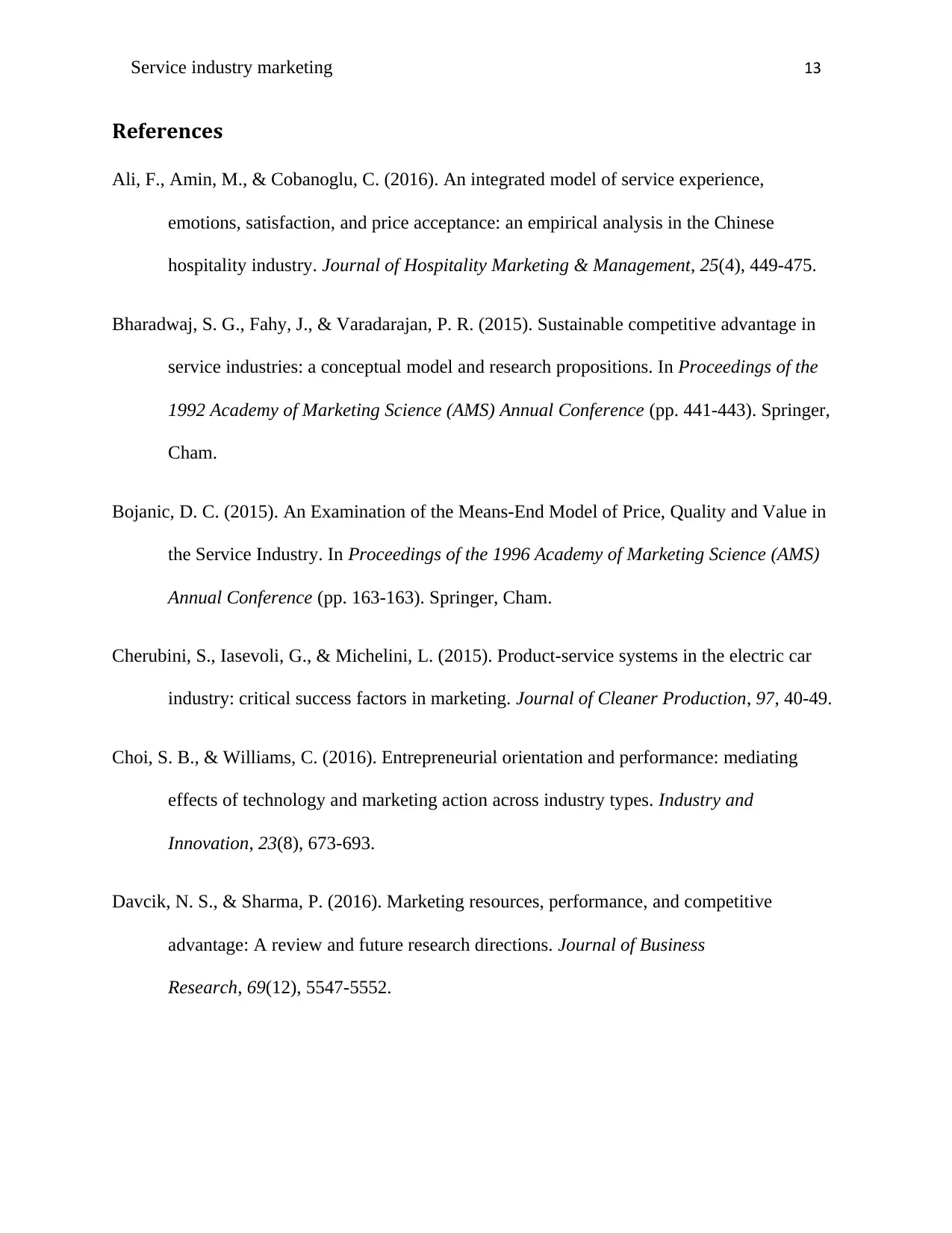
Service industry marketing 13
References
Ali, F., Amin, M., & Cobanoglu, C. (2016). An integrated model of service experience,
emotions, satisfaction, and price acceptance: an empirical analysis in the Chinese
hospitality industry. Journal of Hospitality Marketing & Management, 25(4), 449-475.
Bharadwaj, S. G., Fahy, J., & Varadarajan, P. R. (2015). Sustainable competitive advantage in
service industries: a conceptual model and research propositions. In Proceedings of the
1992 Academy of Marketing Science (AMS) Annual Conference (pp. 441-443). Springer,
Cham.
Bojanic, D. C. (2015). An Examination of the Means-End Model of Price, Quality and Value in
the Service Industry. In Proceedings of the 1996 Academy of Marketing Science (AMS)
Annual Conference (pp. 163-163). Springer, Cham.
Cherubini, S., Iasevoli, G., & Michelini, L. (2015). Product-service systems in the electric car
industry: critical success factors in marketing. Journal of Cleaner Production, 97, 40-49.
Choi, S. B., & Williams, C. (2016). Entrepreneurial orientation and performance: mediating
effects of technology and marketing action across industry types. Industry and
Innovation, 23(8), 673-693.
Davcik, N. S., & Sharma, P. (2016). Marketing resources, performance, and competitive
advantage: A review and future research directions. Journal of Business
Research, 69(12), 5547-5552.
References
Ali, F., Amin, M., & Cobanoglu, C. (2016). An integrated model of service experience,
emotions, satisfaction, and price acceptance: an empirical analysis in the Chinese
hospitality industry. Journal of Hospitality Marketing & Management, 25(4), 449-475.
Bharadwaj, S. G., Fahy, J., & Varadarajan, P. R. (2015). Sustainable competitive advantage in
service industries: a conceptual model and research propositions. In Proceedings of the
1992 Academy of Marketing Science (AMS) Annual Conference (pp. 441-443). Springer,
Cham.
Bojanic, D. C. (2015). An Examination of the Means-End Model of Price, Quality and Value in
the Service Industry. In Proceedings of the 1996 Academy of Marketing Science (AMS)
Annual Conference (pp. 163-163). Springer, Cham.
Cherubini, S., Iasevoli, G., & Michelini, L. (2015). Product-service systems in the electric car
industry: critical success factors in marketing. Journal of Cleaner Production, 97, 40-49.
Choi, S. B., & Williams, C. (2016). Entrepreneurial orientation and performance: mediating
effects of technology and marketing action across industry types. Industry and
Innovation, 23(8), 673-693.
Davcik, N. S., & Sharma, P. (2016). Marketing resources, performance, and competitive
advantage: A review and future research directions. Journal of Business
Research, 69(12), 5547-5552.
Paraphrase This Document
Need a fresh take? Get an instant paraphrase of this document with our AI Paraphraser
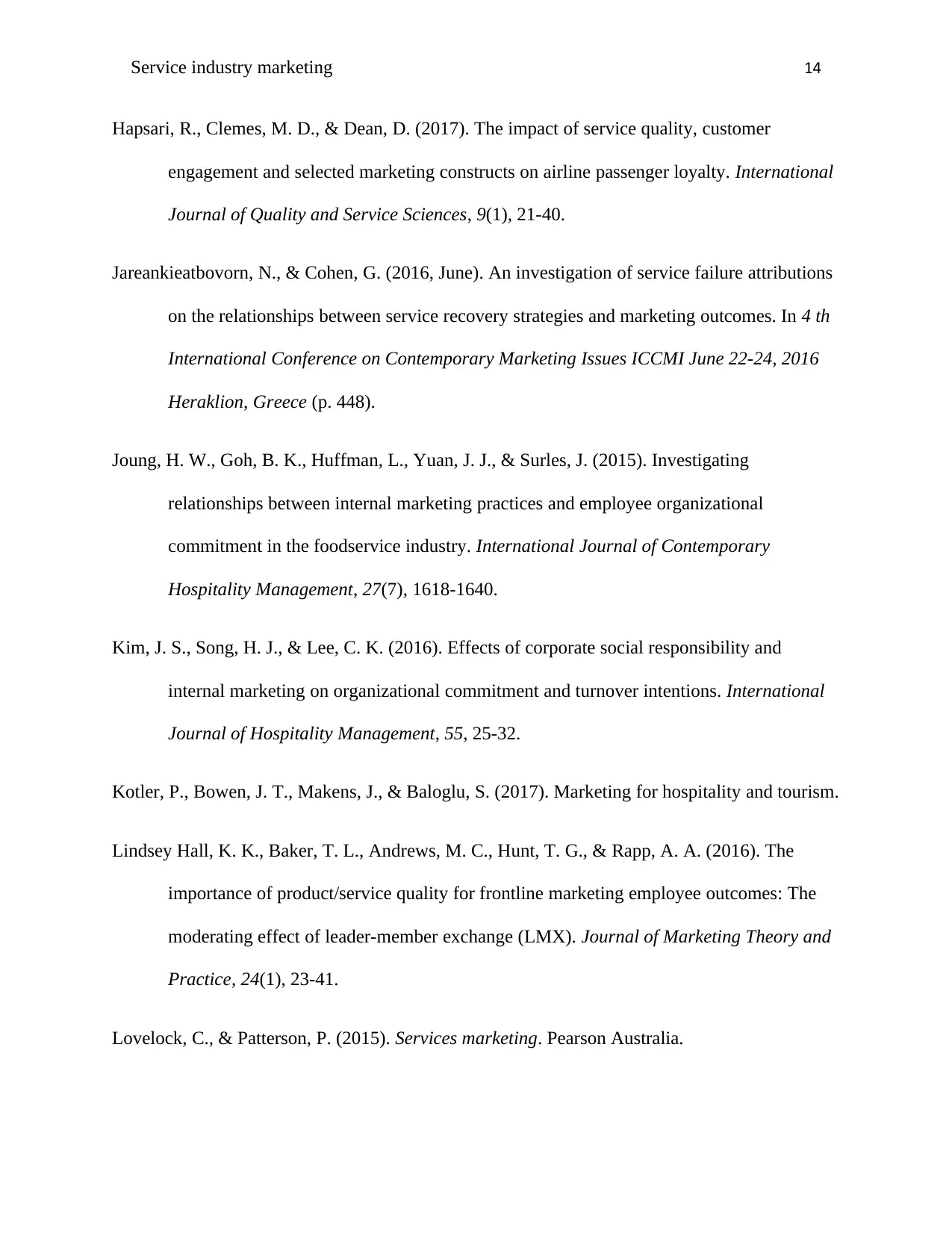
Service industry marketing 14
Hapsari, R., Clemes, M. D., & Dean, D. (2017). The impact of service quality, customer
engagement and selected marketing constructs on airline passenger loyalty. International
Journal of Quality and Service Sciences, 9(1), 21-40.
Jareankieatbovorn, N., & Cohen, G. (2016, June). An investigation of service failure attributions
on the relationships between service recovery strategies and marketing outcomes. In 4 th
International Conference on Contemporary Marketing Issues ICCMI June 22-24, 2016
Heraklion, Greece (p. 448).
Joung, H. W., Goh, B. K., Huffman, L., Yuan, J. J., & Surles, J. (2015). Investigating
relationships between internal marketing practices and employee organizational
commitment in the foodservice industry. International Journal of Contemporary
Hospitality Management, 27(7), 1618-1640.
Kim, J. S., Song, H. J., & Lee, C. K. (2016). Effects of corporate social responsibility and
internal marketing on organizational commitment and turnover intentions. International
Journal of Hospitality Management, 55, 25-32.
Kotler, P., Bowen, J. T., Makens, J., & Baloglu, S. (2017). Marketing for hospitality and tourism.
Lindsey Hall, K. K., Baker, T. L., Andrews, M. C., Hunt, T. G., & Rapp, A. A. (2016). The
importance of product/service quality for frontline marketing employee outcomes: The
moderating effect of leader-member exchange (LMX). Journal of Marketing Theory and
Practice, 24(1), 23-41.
Lovelock, C., & Patterson, P. (2015). Services marketing. Pearson Australia.
Hapsari, R., Clemes, M. D., & Dean, D. (2017). The impact of service quality, customer
engagement and selected marketing constructs on airline passenger loyalty. International
Journal of Quality and Service Sciences, 9(1), 21-40.
Jareankieatbovorn, N., & Cohen, G. (2016, June). An investigation of service failure attributions
on the relationships between service recovery strategies and marketing outcomes. In 4 th
International Conference on Contemporary Marketing Issues ICCMI June 22-24, 2016
Heraklion, Greece (p. 448).
Joung, H. W., Goh, B. K., Huffman, L., Yuan, J. J., & Surles, J. (2015). Investigating
relationships between internal marketing practices and employee organizational
commitment in the foodservice industry. International Journal of Contemporary
Hospitality Management, 27(7), 1618-1640.
Kim, J. S., Song, H. J., & Lee, C. K. (2016). Effects of corporate social responsibility and
internal marketing on organizational commitment and turnover intentions. International
Journal of Hospitality Management, 55, 25-32.
Kotler, P., Bowen, J. T., Makens, J., & Baloglu, S. (2017). Marketing for hospitality and tourism.
Lindsey Hall, K. K., Baker, T. L., Andrews, M. C., Hunt, T. G., & Rapp, A. A. (2016). The
importance of product/service quality for frontline marketing employee outcomes: The
moderating effect of leader-member exchange (LMX). Journal of Marketing Theory and
Practice, 24(1), 23-41.
Lovelock, C., & Patterson, P. (2015). Services marketing. Pearson Australia.
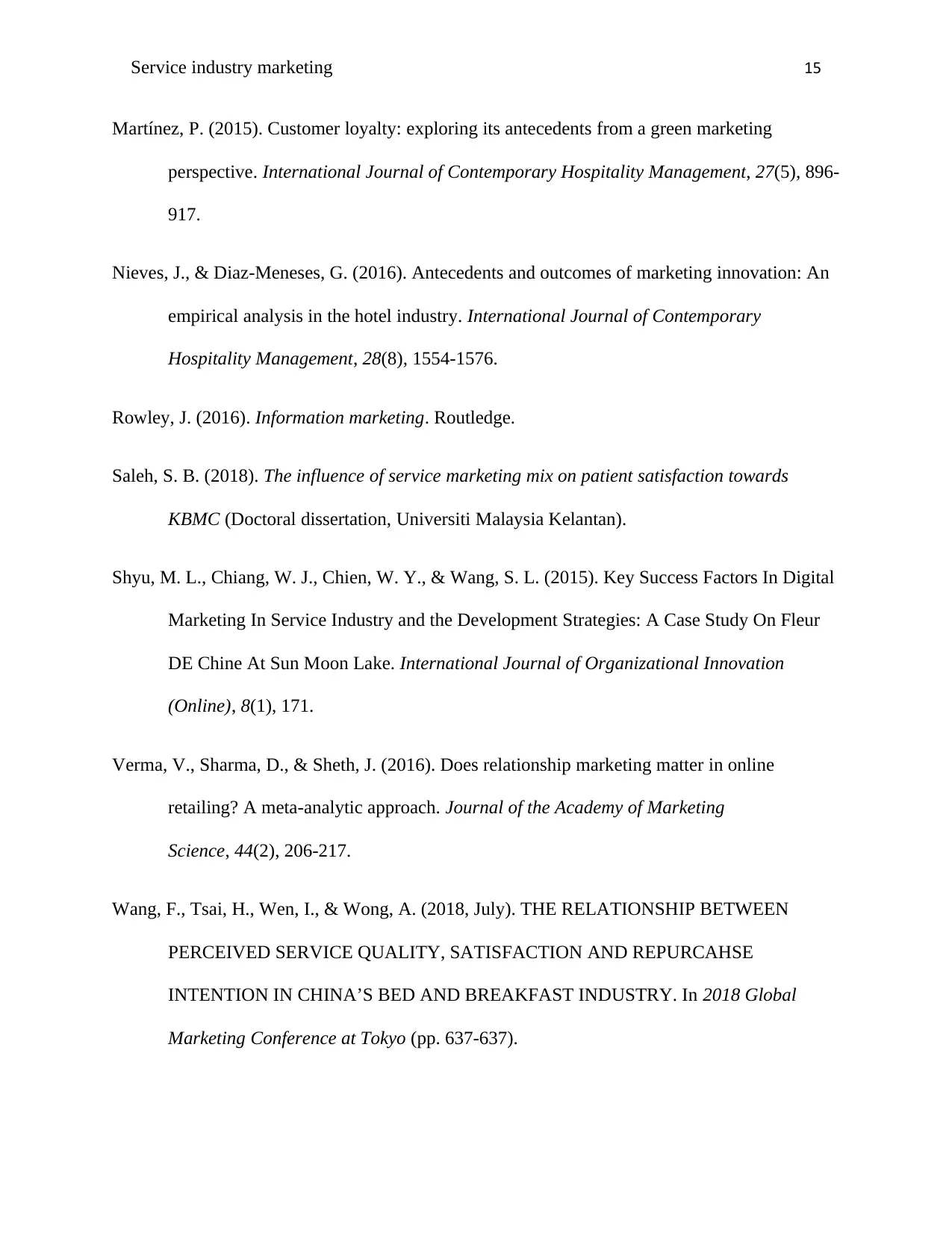
Service industry marketing 15
Martínez, P. (2015). Customer loyalty: exploring its antecedents from a green marketing
perspective. International Journal of Contemporary Hospitality Management, 27(5), 896-
917.
Nieves, J., & Diaz-Meneses, G. (2016). Antecedents and outcomes of marketing innovation: An
empirical analysis in the hotel industry. International Journal of Contemporary
Hospitality Management, 28(8), 1554-1576.
Rowley, J. (2016). Information marketing. Routledge.
Saleh, S. B. (2018). The influence of service marketing mix on patient satisfaction towards
KBMC (Doctoral dissertation, Universiti Malaysia Kelantan).
Shyu, M. L., Chiang, W. J., Chien, W. Y., & Wang, S. L. (2015). Key Success Factors In Digital
Marketing In Service Industry and the Development Strategies: A Case Study On Fleur
DE Chine At Sun Moon Lake. International Journal of Organizational Innovation
(Online), 8(1), 171.
Verma, V., Sharma, D., & Sheth, J. (2016). Does relationship marketing matter in online
retailing? A meta-analytic approach. Journal of the Academy of Marketing
Science, 44(2), 206-217.
Wang, F., Tsai, H., Wen, I., & Wong, A. (2018, July). THE RELATIONSHIP BETWEEN
PERCEIVED SERVICE QUALITY, SATISFACTION AND REPURCAHSE
INTENTION IN CHINA’S BED AND BREAKFAST INDUSTRY. In 2018 Global
Marketing Conference at Tokyo (pp. 637-637).
Martínez, P. (2015). Customer loyalty: exploring its antecedents from a green marketing
perspective. International Journal of Contemporary Hospitality Management, 27(5), 896-
917.
Nieves, J., & Diaz-Meneses, G. (2016). Antecedents and outcomes of marketing innovation: An
empirical analysis in the hotel industry. International Journal of Contemporary
Hospitality Management, 28(8), 1554-1576.
Rowley, J. (2016). Information marketing. Routledge.
Saleh, S. B. (2018). The influence of service marketing mix on patient satisfaction towards
KBMC (Doctoral dissertation, Universiti Malaysia Kelantan).
Shyu, M. L., Chiang, W. J., Chien, W. Y., & Wang, S. L. (2015). Key Success Factors In Digital
Marketing In Service Industry and the Development Strategies: A Case Study On Fleur
DE Chine At Sun Moon Lake. International Journal of Organizational Innovation
(Online), 8(1), 171.
Verma, V., Sharma, D., & Sheth, J. (2016). Does relationship marketing matter in online
retailing? A meta-analytic approach. Journal of the Academy of Marketing
Science, 44(2), 206-217.
Wang, F., Tsai, H., Wen, I., & Wong, A. (2018, July). THE RELATIONSHIP BETWEEN
PERCEIVED SERVICE QUALITY, SATISFACTION AND REPURCAHSE
INTENTION IN CHINA’S BED AND BREAKFAST INDUSTRY. In 2018 Global
Marketing Conference at Tokyo (pp. 637-637).
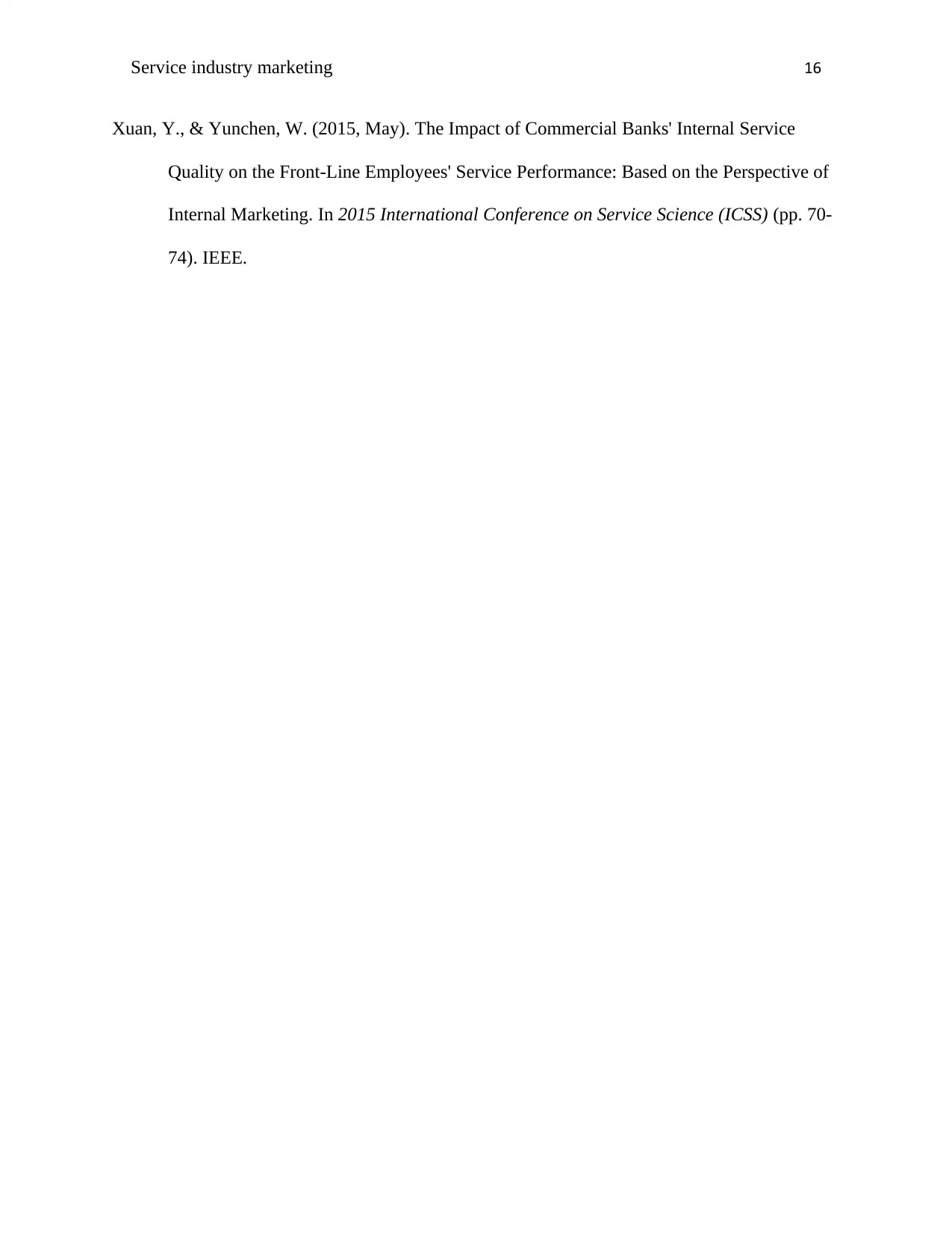
Service industry marketing 16
Xuan, Y., & Yunchen, W. (2015, May). The Impact of Commercial Banks' Internal Service
Quality on the Front-Line Employees' Service Performance: Based on the Perspective of
Internal Marketing. In 2015 International Conference on Service Science (ICSS) (pp. 70-
74). IEEE.
Xuan, Y., & Yunchen, W. (2015, May). The Impact of Commercial Banks' Internal Service
Quality on the Front-Line Employees' Service Performance: Based on the Perspective of
Internal Marketing. In 2015 International Conference on Service Science (ICSS) (pp. 70-
74). IEEE.
1 out of 16
Related Documents
Your All-in-One AI-Powered Toolkit for Academic Success.
+13062052269
info@desklib.com
Available 24*7 on WhatsApp / Email
![[object Object]](/_next/static/media/star-bottom.7253800d.svg)
Unlock your academic potential
© 2024 | Zucol Services PVT LTD | All rights reserved.





